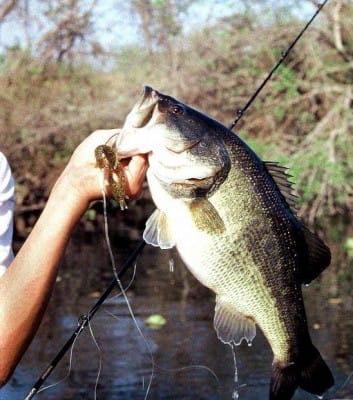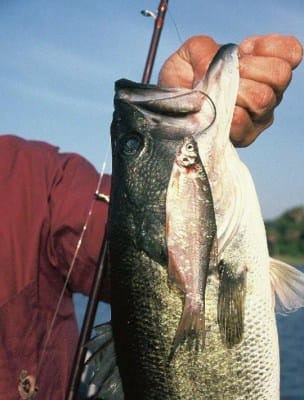Submitted By:
Bob McNally – USA Guest Author
 Jimmy Carter was in the White House. The Mariel boat lift was winding down. And nearly two dozen Americans were fishing from boats with Russian-made “Mockba” outboard motors in a virgin lake near the city of Moron, smack in the middle of Cuba.
Jimmy Carter was in the White House. The Mariel boat lift was winding down. And nearly two dozen Americans were fishing from boats with Russian-made “Mockba” outboard motors in a virgin lake near the city of Moron, smack in the middle of Cuba.
It was the early 1980s, and while 125,000 Cubans seeking American freedom were pouring into south Florida (courtesy of Castro and Carter), American fishermen were quick to leap to the island nation in hopes of catching the next world-record bass.
A number of Cuban bass lakes had been tested by U.S. anglers at that time, and reports of near-record largemouths were substantial from highly-touted Cuban waters like Treasure Lake and Lake Zaza.
That’s when I received a phone call from Dan Snow, a Houston entrepreneur who was setting up packaged fishing tours for American anglers to the island of Cuba. Snow wanted publicity, and said he was opening a new Cuban lake to anglers and wanted me to go.
Lake Redonda (“round” in Spanish) it was called, and it was infested with huge and gullible bass.
I was young and adventurous, and jumped at the chance to visit Cuba.

So a few weeks later 20 other fishermen and I left Fort Lauderdale, Florida, in an old but reliable DC3 and flew two hours to the central Cuban city of Camaguay. From there we were met by an in-country tour guide named Jose, and we drove three hours to the town of Moron. We were housed in a multi-story new hotel with clean sheets, hot water, a pool and television. Great modern conveniences, but in the shadows lurked the omnipresence of Fidel’s oppression and communism.
Best Bass Fishing to be Found
Fishing served as the centerpiece for dialogue and mutual respect between Americans and Cubans, and the bass fishing on Lake Redonda was the star. To this day it is the best largemouth angling I’ve experienced anywhere at any time. And having lived in Florida for more than 30 years, I’ve had some memorable days in many places, including California and Texas, Mexico and Honduras.
We fished Redonda three days, as the first modern Americans to tap the lake. And the bass acted like it. We’d fish from daybreak to mid-day, take a siesta and lunch in a lake-side cabana, then fish from early afternoon until dark. Two men and a Cuban guide fished per boat, and I guess we caught 75 to 150 bass per day. They’d range all sizes, but there were staggering numbers of 4 to 8 pounders. Some touched 10 pounds, and the biggest I saw might have made 11 pounds.
But oh, how good the fishing was.
Redonda is clear, big and round, near the coast, and surrounded with a maze of tangle-root mangroves. It looks like south Florida snook country, though we never saw or heard of snook there. The lake held 50-pound class tarpon, however, and while we chased schools of them and cast to plenty, none were hooked.
Why chase tarpon when the bass action was among the best in the world?

One memory might show how phenomenal the fishing was. My boat partner and I were casting to a mangrove shore getting nice bass regularly, often seeing schools of 4- to 6-pounders swimming along. I spotted a solo 6-pounder in 4 feet of clear water holding just outside mangrove roots. I cast a 12-inch plastic worm to the fish, opting for big lures to thwart the constant strikes of small bass under 3-pounds. We watched the bass immediately come to my lure, suck it in, and I set the hook.
It fought great, cutting back left and right, but after a couple minutes I got control of the fish, only to have it leap high and throw my lure. I watched the fish plop down in Redonda’s clear water, then turn toward the mangroves and safety. I alerted my pal to the fish, and he immediately dropped a second plastic worm on it.
The 6-pounder hit his lure, slugged a bit, and then that second hook pulled free.
I was ready, spotted the mostly-whipped bass settle, and cast my plastic worm to it. It hit – for a third time – and I pulled in a beaten and incredibly unsophisticated bass. It surely was a fish that had never seen a lure, heard a motor, nor knew anglers were out-and-about.
There were no boat depthfinders, and only weak electric motors, but the guides were skilled and enthusiastic. I remember the fiberglass boats were serviceable, but pretty rough. The outboards were Russian-made Mockbas, and they were a disaster. None had cowlings because they were worked on so frequently by guides and mechanics. To turn off the motor, a guide placed his hand over the exposed carburetor to choke off the engine.
In each boat there was a small flat pole onto which a large white pennant could be raised. The guide raised the flag when the motor died and couldn’t be restarted. That signaled a “rescue boat” that would travel around the lake looking for broken down boats, and would then swap out one Mockba for another.
This was during the height of the Cold War, and the Russians were not our pals. So the joke of the Redonda trip was that “if Russians make ICBMs like they make Mockba outboard motors, the U.S. has nothing to worry about.”
After three days of catching and releasing Redonda bass nearly non-stop, our hands from holding and releasing so many fish were so worn raw by sandpaper lips of largemouths, that we had to tape our thumbs and fingers to prevent bleeding.
Memories of that Cuban fishing trip are still vivid, and I can only hope that one day I will have a chance to fish those waters once again.







